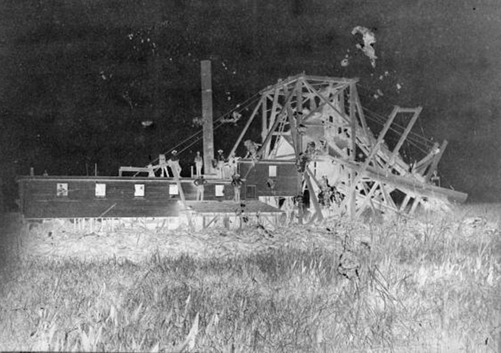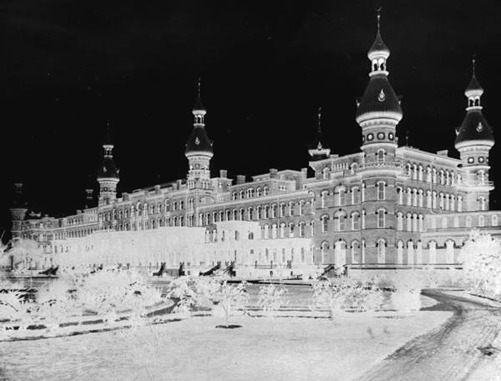The History of Florida (58 page)
Read The History of Florida Online
Authors: Michael Gannon
Tags: #History, #United States, #State & Local, #Americas

———. “Political Reconstruction in Florida.”
Florida
Historical
Quarterly
45, no. 2 (Octo-
ber 1966):145–70.
Wal ace, John.
Carpetbag
Rule
in
Florida:
The
Inside
Workings
of
the
Reconstruction
of
Civil
Government
in
Florida
after
the
Close
of
the
Civil
War.
1888. Gainesville: University of Florida Press, 1964.
16
The First Developers
Thomas Graham
In 1877, Florida ranked as the least populous and most thinly settled state
east of the Mississippi River, with only about 250,000 residents. However,
over the fol owing forty years Florida would grow at a rate approaching
twice the pace of the United States. Floridians could sense that change was
on the way. Both large developers and individual pioneers saw Florida as a
raw wilderness ripe for improvement.
Florida’s political leaders understood that the state needed to attract both
immigrants from the North and investment capital to build its economy. To
proof
encourage rich outsiders to invest in the state, they pursued policies of low
taxes and minimal government interference with businesses. The most im-
portant field of investment was railroad building. While steamboats could
serve in areas with navigable rivers, most regions of the state would remain
undeveloped until railroads could be built to connect them with the outside
world.
Before the Civil War, the state had been a Deep South cotton and slave
state much like its neighbors Georgia and Alabama. Most of Florida’s popu-
lation clustered along its northern border. As railroads extended down the
peninsula, the center of population moved southward. New enterprises such
as citrus growing, phosphate mining, and tourism moved Florida society
away from the cotton culture. In 1872 Henry Sanford, a former U.S. diplo-
mat, established a plantation on Lake Monroe in central Florida to grow
winter vegetables, and in 1876 Henry DeLand founded a town that he hoped
would prosper with the cultivation of oranges. Many people continued to
eke out a living as tenant farmers or sharecroppers, growing corn, cotton,
and tobacco or catching open-range cattle just as their fathers had, but the
future clearly lay along the path of the steel rails into the peninsula in what
was emerging as the Sunshine State.
· 276 ·
The First Developers · 277
The governor who took office in January 1877, George F. Drew, had been
selected by the Democrats to raise as little controversy as possible at a time
when Reconstruction was coming to an end. Drew had been born in New
Hampshire but had lived in Florida before the war. He operated a large saw-
mill at El aville on the Suwannee River and was a businessman, not a politi-
cian. Since he had been a Whig before the war and supported the Union
during the war, he could appeal to moderate white men and still be accept-
able to conservative Democrats. Black Floridians hoped that he would not
reverse the gains made by black citizens during Reconstruction.
Drew and the legislature focused their attention on putting the state’s
economic house in order. They embarked on a program of reducing govern-
ment spending that severely impacted support for public schools. A pro-
posal to establish a state college at Eau Gallie was dropped. The legislature
passed a law that provided for the leasing of state penitentiary inmates to
private businesses. The measure served to cut state expenses but raised se-
rious questions about the exploitation and abuse of prisoners by private
contractors. Often convict laborers were employed in arduous work that
free men could not be induced to undertake.
By 1880, the Democrats felt they no longer needed the compromise can-
didate Drew and nominated their champion, William D. Bloxham, a native-
proof
born Florida plantation owner and lawyer from Tal ahassee and a veteran of
the Confederate military. Though he had fought for the Old South, he now
envisioned a New South of modern businesses and industries. He stressed
the need for sound finances in state government. The previous legislature’s
enthusiasm for cutting taxes, combined with the nationwide economic re-
cession of the 1870s, had left the state with a large public debt.
The only major financial asset of the state, its public lands, had been used
as col ateral for bonds issued by various railroad ventures that subsequently
went bankrupt, leaving the state responsible for a $1 mil ion debt, which
constantly grew because of the accumulation of unpaid interest. When the
state continued to make deals to give away land in exchange for promises
to build railroads and drain swamps, one of the major bondholders, Fran-
cis Vose, a New York investor, filed suit in federal court, which placed the
state’s custodian of lands, the Internal Improvement Commission, into re-
ceivership and refused to allow any further alienation of state lands except
for hard cash or until the bonded debt was paid. This effectively blocked
the most promising way of encouraging investment in the state. Since the
governor served as head of the Internal Improvement Commission, respon-
sibility for resolving this impasse fell to him.

278 · Thomas Graham
Hamilton Disston’s dredges floated on barges that cut a pathway through wetlands
to excavate drainage canals. This photo was taken on the St. Cloud Canal south of Or-
lando. Courtesy of the State Archives of Florida,
Florida Memory
, http://floridamemory.
com/items/show/138343.proof
Bloxham traveled north and personal y negotiated an agreement with
Philadelphia industrialist Hamilton Disston to eliminate the Internal
Improvement Commission’s debt. The deal had two parts: for $1 mil ion
in cash, Disston purchased 4 mil ion acres of land outright, and he also
gained the option to drain an additional 9 mil ion acres of swampland at
his own expense, dividing the drained land equal y between himself and
the state. The land to be drained encompassed the Kissimmee River and
Lake Okeechobee water basins. Disston established real estate companies
in the North and in Europe to sell land to immigrants, making him one of
the largest promoters of Florida.
His dredges began digging south from the town of Kissimmee to
straighten the Kissimmee River so that it would carry water rapidly into
Lake Okeechobee. At the same time, another crew excavated a canal from
the mouth of the Caloosahatchee into Lake Okeechobee at Moore Haven
so that water from the lake would flow into the Gulf of Mexico. Disston
established a sugar plantation at St. Cloud south of Orlando on drained
land. After a few years it became clear that lowering the water table of Lake
Okeechobee would require dredging many more canals.
The First Developers · 279
The Disston land deals became a major issue in state politics. Critics
argued that Governor Bloxham had been too hasty in making a deal that
sold land for twenty-five cents per acre when the usual price for undevel-
oped government land was $1.25 per acre. Opponents also said that Disston
claimed land that he had not drained and that he had pushed pioneer squat-
ters off the land they had been living on. Moreover, many felt that it was
simply wrong for a handful of wealthy men to own so much of the state.
Another of Florida’s important developers, Henry Bradley Plant, helped
to connect the remote frontier state of Florida with the rest of the country
by modernizing the South’s railroads. Born in Connecticut, Plant rose in
the ranks of the Adams Express Company before the war to become super-
intendent of its shipping operations in the South. When war came, Plant
organized his own firm to serve the Confederacy. After the war, Plant pur-
chased a railroad he renamed the Savannah, Florida and Western, and in
1881 he extended its line directly to Jacksonville. Plant established his home
in New York City on Fifth Avenue to be near the financial markets and to
attract northern investors in his growing railroad system.
Reaching out from his foothold in Jacksonville, Plant purchased control-
ling interest in the South Florida Railroad in 1883 and extended its south-
ernmost terminus from Kissimmee to Tampa, a town of 700 souls. He began
proof
to turn Tampa into a major metropolis by building a deepwater port on
Tampa Bay from which his steamships could trade with Cuba and the Ca-
ribbean. In 1891 he opened the fantastic Tampa Bay Hotel as an attraction
for wealthy northern visitors during the winter months. Eventual y Plant
would own eight hotels in central Florida and along the Gulf coast. All the
while he continued either to purchase or to build additional railroad lines
until most of the western half of the peninsula as far south as Punta Gorda
seemed to be Plant’s domain.
One of Plant’s neighbors in New York City, living a block away on Fifth
Avenue, was Henry M. Flagler, a partner with John D. Rockefeller in Stan-
dard Oil Company. Flagler invested in Plant’s Southern railway ventures. He
came to Florida in 1878 with his first wife, Mary, and traveled to St. Augus-
tine in the hope that warm air and sunlight might improve her health. How-
ever, Flagler found the surroundings in America’s oldest city depressing. He
quickly returned north, where Mary soon died. Six years later, fol owing
Flagler’s remarriage to his second wife, Alice, he returned to St. Augustine
and was surprised to discover that the town was filled with healthy, prosper-
ous northerners who had come simply to enjoy themselves.1
Flagler saw that improvements in the South’s railroad connections made

280 · Thomas Graham
Henry Plant opened his Tampa Bay Hotel in 1891. Legend has it that when Henry Flagler
asked how to find Tampa, Plant replied, “Just follow the crowds.” Actually, the hotel was
not a commercial success, but it briefly became famous as headquarters for U.S. Army
proof
officers during the Spanish-American War. Courtesy of the State Archives of Florida,
Florida Memory
, http://floridamemory.com/items/show/31956.
it practical for the growing class of affluent people in northern states to
travel to Florida. Flagler realized he could profit from this significant de-
velopment in American transportation by opening fine winter resort hotels
in Florida and building a railroad to connect them with customers coming
down in search of sunshine and pleasure.
In 1885 he began construction of the elegant Hotel Ponce de Leon and its
companion, the Hotel Alcazar in St. Augustine. When they opened in 1888,
they were the first large buildings in America to be constructed of concrete.
Designed by architects Thomas Hastings and John Carrère, the hotels intro-
duced Spanish-style architecture to modern Florida.
To ensure convenient, reliable transportation to his hotels, Flagler pur-
chased the Jacksonvil e, St. Augustine & Halifax River Railroad in 1885.
The acquisition of this railroad, with charter rights to build all the way to
Daytona, gave Flagler an incentive to extend his range down the east coast.
